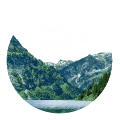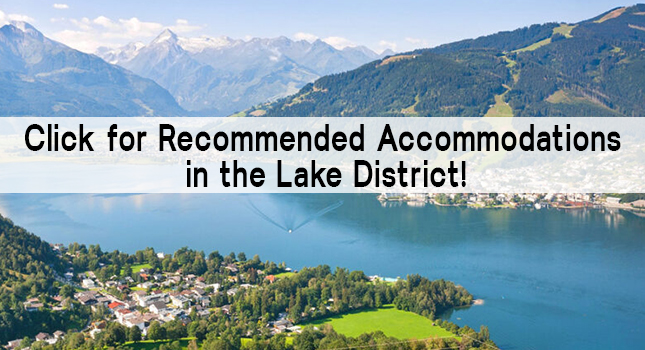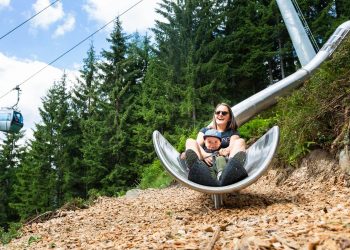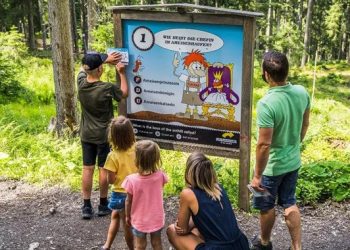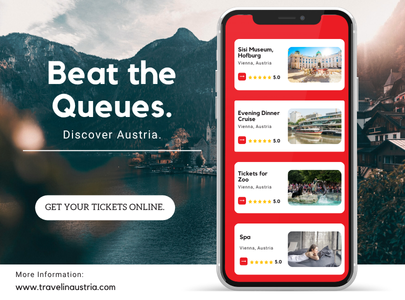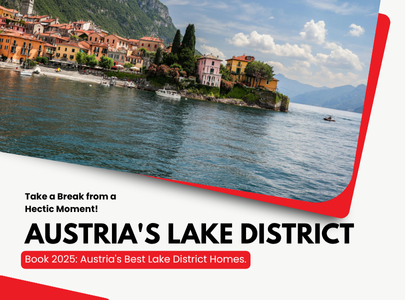The City of Salzburg – Dive into a World of Music and Culture
The city of Salzburg, also known by its tourist name “The City of Mozart,” is the capital of the Salzburg region. The city is home to about 150,000 residents, making it the fourth-largest city in Austria (after Vienna, Graz, and Linz). The famous composer Wolfgang Amadeus Mozart was born and raised in Salzburg, and the renowned movie “The Sound of Music” was partially filmed within the city.
The meaning of the name Salzburg is “Salt Fortress,” a testament to the extensive salt mining in the area that made it so rich and prosperous. Salt, also known as “the white gold,” turned Salzburg into one of the wealthiest regions in Europe in the 17th century.
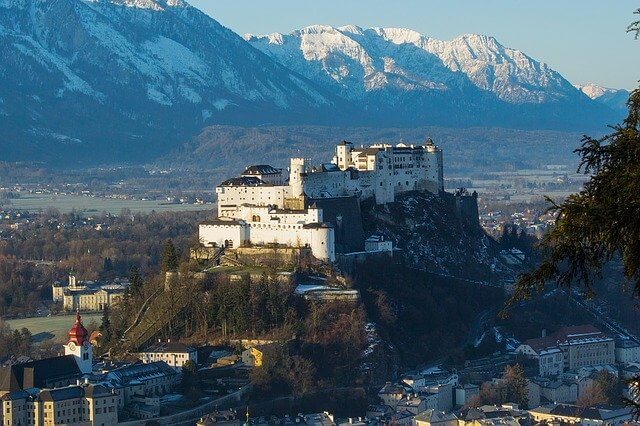
The city is situated on the banks of the Salzach River, north of the Alpine mountain range, at an altitude of 430 meters above sea level. The closest mountain to the city is called Untersberg, and its height is 1,972 meters above sea level. Additionally, the city is characterized by a wonderful combination of beautiful hills and ancient buildings. The old town center is remarkably preserved, featuring magnificent Baroque-style structures. For this reason, the center of Salzburg is recognized as a UNESCO World Heritage site.
You can easily spend two or three days in the city of Salzburg itself. To ensure you are prepared for your trip to this wonderful city, we have created a comprehensive guide with all the essential information for your visit. Keep reading to find the most important information for visiting the capital of Salzburgerland!
You can navigate between the sections of the article by clicking the links in the table of contents:
Table of Contents
- The Story of Salzburg
- The Jews in Salzburg – Then and Now (including information on the Chabad House)
- The Weather
- A Collection of Recommended Attractions
- 16 Must-See Places in the Heart of the Old Town
- 6 Additional Attractions: Hellbrunn Palace, Mirabell Palace, the Zoo, and More
- 3 Viewpoints Overlooking the City
- Recommended Classical Concerts with an Exclusive Discount!
- Cruise on the Salzach River
- Tickets for a Panoramic Tour Including a Cruise
- Two Recommended Day Trips Outside the City
- Tickets for a Trip to the Eagle’s Nest
- Tickets for a Trip to the Salt Mines in Germany
- Recommended Restaurants and Cafes
- Shopping – Recommended Malls
- Tax Refund on Shopping in Salzburg – How Does It Work?
- Recommended Hotels in Salzburg for Every Budget – A Detailed List
- The Salzburg Card
- Purchase the Salzburg Card Online
- Other Essential Information for Visiting the City
The Story of the City of Salzburg – From Antiquity to the Present Day
The flat area north of the Alps has served as a living space for humans since ancient times, with the Celts inhabiting this region. When the area was under the control of the Roman Empire, the small Celtic settlements were united and became a single city. In Roman times, the city was called Juvavum and was an important city on the northern border of the Empire. After the defeat of the Romans and the collapse of the Empire, the city was almost completely abandoned and nearly fell into ruin.
Ancient texts describe the city’s revival thanks to Saint Rupert, who was appointed bishop in the 8th century AD by the Duke of Bavaria. Rupert established his church in the city and turned it into an active religious center. It was he who changed the city’s name to Salzburg because of the vessels that would pass through the river, via the city, carrying salt from the mines operating in the area. Those passing through the river were required to pay a transit tax to continue on their way, and thus the city began to grow wealthy. In the 11th century, the Hohensalzburg Fortress was built to protect the area.
In the 14th century, the city gained independence from Bavaria and served as the seat of the Archbishop of Salzburg, who acted on behalf of the Holy Roman Empire. The city continued to prosper, and in the 17th century, the city center was rebuilt in the Baroque style, with magnificent palaces and churches added.
In the early 19th century, after the fall of the Holy Roman Empire, the city was annexed to the newly established Austrian Empire. However, a few years later, in 1809, it passed to the Kingdom of Bavaria after Austria’s defeat against Napoleon at the Battle of Wagram. It was not until 1816 that this region was returned to Austria.
Salzburg in World War II
During World War II, the city was under Nazi rule, and German military forces were stationed in the area. The city’s Jews were deported to labor and extermination camps, and the synagogue was destroyed. Throughout the war, the city was bombed about 15 times, and approximately 46% of the buildings in the city were damaged in the numerous bombings. Fortunately, most of the buildings in the Old Town, the Cathedral, and the bridges remained standing without damage. In 1945, American forces captured the area, and it became part of the Austrian territories that were under American rule for a time.
After the war ended, Salzburg became the capital of the Salzburg region and today serves as an extremely popular tourist destination. The old city center and the beautiful mountain landscapes attract many tourists from all over the world, but its status as Mozart’s birthplace and the filming location for “The Sound of Music” are also important factors in promoting tourism to the city.
The Jews in Salzburg – Then and Now
Throughout the Middle Ages, Salzburg was known as a deeply religious place, ruled for many years by archbishops and the Catholic faith. Despite being a devoutly Christian city, many Jews lived there.
Jews arrived in Salzburg as early as the Roman period and lived there for many centuries. Even after the fall of the Roman Empire and the collapse of the Roman city of Juvavum, they continued to reside in the city and played a significant role in its development.
Ancient writings prove that as early as the 12th century, there was a street in the heart of the city called Judengasse (Jews’ Street), where an ancient synagogue was located (a luxury hotel stands on this site today).
In the 15th century, the city’s Jews experienced severe pogroms, and they were forbidden to settle within the city limits. This prohibition prevented a Jewish community from developing in Salzburg until the 19th century. In 1893, a synagogue was established, followed by a Jewish cemetery. Important Jewish figures lived in the city during this period, such as the writer Stefan Zweig, Theodor Herzl (who was in the city for a short period), Adolf Altmann, Max Reinhardt, and others.
During the Holocaust, the property of the Jews was confiscated, the synagogue was destroyed, and many were deported or sent to extermination camps. Today, the Jewish community numbers around 100 members, and the synagogue has been restored and serves for prayers and community needs. The head of the Jewish community in Salzburg is Marko Feingold, who is 105 years old.
Chabad House in Salzburg & Shabbat Meals
In Salzburg, there is a Chabad House managed by Rabbi Menachem Grozman and his wife, Chani Grozman. The Chabad House is located at Getreidegasse 13, 5020 Salzburg. At the Chabad House, you can have Shabbat evening/day meals and receive assistance if needed. Link to the Chabad House in Salzburg website.
The Weather in Salzburg Throughout the Year
The city of Salzburg is characterized by a relatively moderate climate for the region. The winter months are very cold, and from December to February, the temperature hovers around 0°C (32°F). The summer months are not particularly hot, with an average daytime temperature of about 19°C (66°F). In terms of rainfall, the summer months are generally rainier, with an average of about 11 rainy days per month. June is the wettest month of the year, with an average of about 15 rainy days. Of course, there are more hours of sunshine in the summer months, and between May and September, there is an average of about 7 hours of sunshine per day.
For current temperatures and forecast
Recommended Attractions
There is no doubt that there is a lot to see and do in Salzburg, and you need at least two or three days to enjoy everything the city has to offer. To make the choice between the many options easier, we have selected the most recommended attractions in the city so you will know what to focus on.
Recommended Attractions in the Old Town
The Old Town of Salzburg (in German, Altstadt) is located right on the banks of the Salzach River and is one of the most beautiful and well-preserved north of the Alps. For this reason, it has been included in the UNESCO World Heritage list since 1996. The streets of the Old Town are narrow, paved with small stones, and lined with many ancient buildings from the Middle Ages or the Baroque period.

Most of Salzburg’s attractions are located throughout the Old Town and are within a short walking distance of each other. This section mentions 16 important attractions that are recommended to see during a visit to the Old Town.
The main street of the Old Town is called Getreidegasse. It is an active pedestrian street lined with ancient medieval houses, many small shops, cafes, and restaurants. It’s worth wandering into the side alleys to discover the inner courtyards that are less visible but certainly impressive. Besides shops, this street is home to the birthplace of the famous composer Mozart (Mozart’s Geburtshaus). Mozart lived in this house for 17 years, and today it houses a museum showcasing the life of the great composer and some of his musical instruments.
At the eastern end of the shopping street begins Kranzlmarkt street, and next to it is the Old Town Hall of Salzburg (Altes Rathaus). This building was once a residence for a wealthy bourgeois family but was purchased by the city in the 15th century to serve as the town hall. The building has a very impressive and beautiful bell tower.
Further down this street begins the narrow and ancient Jews’ Street (Judengasse), which is also lined with small shops and cafes. Several houses along the street are of historical importance – at number 15, there was an ancient synagogue in the Middle Ages, and the composer Heinrich Biber lived at number 13 in the 17th century. On the facade of number 3, there is an impressive Art Nouveau wall decoration, the only one of its kind in Salzburg.
The Heart of the City – Attractions You Won’t Want to Miss
A short walk from Jews’ Street is a large square called Mozartplatz (Mozart Square), in the center of which is a large statue of Mozart and a monument in his memory. Adjacent to the square is an impressive palace complex called the DomQuartier, which includes the Residenz palaces that were the seat of the archbishops. Between the palaces is a large square called Residenzplatz, which features a fountain considered the most beautiful in Salzburg (Residenzbrunnen).
Near the square is the Salzburg Cathedral (Dom zu Salzburg). This cathedral is dedicated to St. Rupert, the city’s founder. It was first built in the 8th century but was renovated due to a fire in the 12th century. Later, in the 17th century, it was completely rebuilt in the Baroque style after another fire damaged the structure. The last renovation of the cathedral was in 1959, but without any significant change to its original appearance. Mozart was baptized in this church. The interior of the cathedral is beautifully decorated and impressive in its beauty, but it is also beautiful from the outside.
Behind the cathedral is a large square (Kapitelplatz) where the cathedral’s monastery once stood. Today, a modern sculpture called Sphaera stands in its place. The sculpture is a large golden sphere with a small statue of a person standing on it.
From the square, you can continue towards St. Peter’s Abbey (Stift Sankt Peter), which was established as early as the 7th century and was one of the most important Christian centers of the city. This monastery is the oldest among the monasteries in German-speaking countries. Next to the monastery is the ancient cemetery (Petersfriedhof) at the foot of the towering Mönchsberg hill. This cemetery is one of the oldest in the world and contains ancient catacombs built into the hill above it.
From the cemetery, you can climb to the top of Mönchsberg hill, at an altitude of 540 meters above sea level. There you will find the fortified Hohensalzburg Fortress (Festung Hohensalzburg), which was built in the Middle Ages and was never conquered. It is one of the largest castles to have survived from the Middle Ages.
Recommended Museums in the Old Town
Inside the Residenz palaces in the heart of the Old Town are several interesting museums, such as the Salzburg Museum, which displays paintings from the 19th century to the present day, and the Panorama Museum, which features a panoramic painting of Salzburg from 1829. You can also take a tour of this complex as part of the museum called the DomQuartier Museum.
If you particularly enjoy museums, you will need to return to the other side of the Old Town to visit the Museum of Natural History (Haus der Natur), which has interesting exhibits on the natural world over thousands of years.
Of course, the Old Town has many more museums, churches, and ancient buildings, but if you are visiting for a short time, it is best to focus on the places mentioned above as they are the most important in the Old Town.
Additional Attractions
Here are 6 more attractions across the Salzach River and in the south of the city that are worth including in your trip to Salzburg. Here you can find the most essential information for visiting these attractions:
Mozart’s Residence
As you’ve already discovered, almost every corner of the city is somehow connected to Mozart. Across the river, you can also visit the house that the Mozart family used from 1773 to 1787. This house is larger than the one in the heart of the Old Town and has 8 rooms. Today, it serves as a museum presenting additional parts of the great composer’s life. Read more about visiting the museum.
Mirabell Palace and Gardens
Mirabell Palace and its gardens (Schloss Mirabell & Mirabellgarten) are located across the river but are still considered part of the historic center of Salzburg. The palace was built in 1606 for Wolf Dietrich Raitenau, who was the ruler of the region.
The palace gardens are also impressive and are designed in a symmetrical and orderly Baroque style. In the gardens, there are beautiful fountains, an old greenhouse, a rose garden, a dwarf garden, and a hedge theater. When standing in the gardens, you can enjoy a beautiful view of the Hohensalzburg Fortress. Read more about Mirabell Palace and the royal gardens.
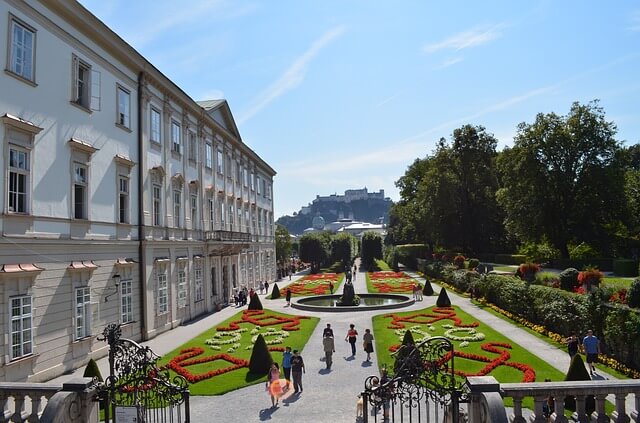
Hellbrunn Palace, the Trick Fountains, and the Gardens
In the southern part of the city, there is an impressive and ancient palace building. In the palace gardens, there is a show of trick fountains that has been amusing visitors to the palace for centuries! Read more about the wonderful Hellbrunn Palace.

Salzburg Zoo
Within the large grounds of Hellbrunn Palace, there is a large zoo with about 1,200 animals. The zoo is especially suitable for children. More information in the detailed article we prepared about the zoo.
Address: Zoo Salzburg, Hellbrunner Straße 60, 5081 Anif/Salzburg
Stiegl Brewery
Salzburg’s brewery, called Stiegl, is the largest in Austria. The brewery’s visitor center is located in the city and provides an enjoyable and intoxicating experience for the senses. Read more about the Stiegl Brewery.
Hangar-7
If you are a fan of aircraft and racing cars or just want to eat at a Michelin-starred restaurant – don’t miss a visit to Hangar-7! This is Red Bull’s museum of aircraft and racing cars. Read more in the detailed article we prepared.

3 Viewpoints Overlooking the City of Salzburg
One of the reasons Salzburg is so beautiful is its wonderful combination of ancient buildings and impressive hills. Right within the city limits, there are several hills that offer a fantastic viewpoint. The most recommended hills in terms of views and proximity to the city center are:
1. Mönchsberg
This hill is located right in the heart of the Old Town, and the Hohensalzburg Fortress stands upon it. The hill rises to a height of about 540 meters above sea level, and from it, you can look out over the buildings of the Old Town. You can walk to the top of the hill or take the funicular from the heart of the Old Town. The funicular ride takes 30 seconds. If you have the Salzburg Card, you can go up and down once for free.
Map:
2. Kapuzinerberg
On the other side of the Salzach River is another hill, 640 meters above sea level. On the hill, there is an ancient monastery and the former home of the famous Jewish writer Stefan Zweig. This hill is considered the “green lung” of the city and is wooded and full of vegetation. You can go on various hiking trails in nature and at the end, reach the top of the hill to enjoy the impressive view of the Old Town. The hike up this hill is recommended for nice, non-rainy days as it requires a prolonged walk on nature trails.
Map:
3. Hellbrunner Berg
This hill is located in the southern part of the city, on the grounds of Hellbrunn Palace. On the hill, there are several ancient buildings, and you can look out from a distance at the Old Town and the Salzburg Fortress.
Map:
If you are willing to leave the city limits and enjoy a wonderful view of the entire area, you can travel to two impressive mountains in the area. The mountains are:
- Gaisberg
- Untersberg
In both places, there are hiking trails in nature. Mount Untersberg rises to a height of 1,972 meters above sea level, and there is a cable car that takes you directly to the summit.
Cruise on the Salzach River
A cruise on the river that crosses the city of Salzburg is a wonderful experience. The cruise is calm and leads to the magnificent Hellbrunn Palace. Read more about the experiential cruise.
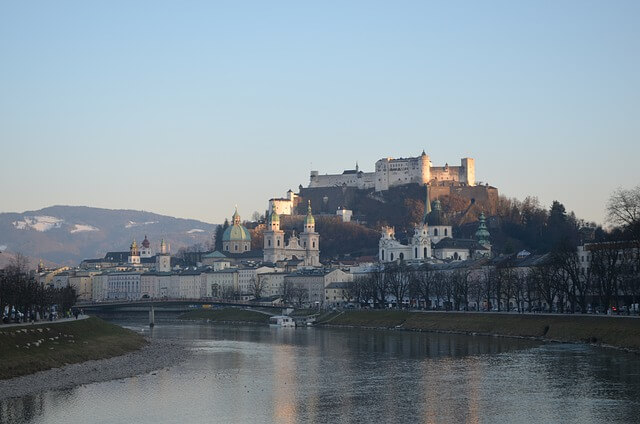
Two Recommended Day Trips Outside the City
If you plan to stay in the city for several days, you can enrich your visit with two recommended guided tours where you can also see the area surrounding the city.
1. Trip to the Eagle’s Nest in Germany
A fairly short drive from the city, across the border with Germany, is a site of great historical importance – this is, of course, the Eagle’s Nest, Adolf Hitler’s residence. On this guided tour, you will first travel to the south of Salzburg to see Hellbrunn Palace and from there continue to the Eagle’s Nest. There, you will hear explanations about the history of the place and can be impressed by the breathtaking views of the entire area. Before returning to Salzburg, you will stop in the picturesque German town of Berchtesgaden. More details about the tour can be found here.
2. The Salt Mines in Germany
This half-day trip includes a visit to the salt mine in Obersalzberg. During the tour, you will receive interesting explanations from the local guide and learn about the world of salt miners in recent centuries. Inside the mine, there is an underground lake where you will take a short boat trip as part of the tour. After visiting the mine, you will continue to the picturesque town of Berchtesgaden and from there back to the center of Salzburg. More details about the tour can be found here.
Recommended Restaurants and Cafes
As part of your visit to the city, you must also try its culinary side. You can find a variety of traditional and international restaurants. We have compiled a list of several recommended restaurants worth knowing:
St. Peter Stiftskulinarium – Das Restaurant
At this place, a dinner is held accompanied by a concert with music by Mozart. The food is based on local Austrian dishes. While you eat, you can enjoy classical music at its best. You can also sit in the part without a concert and pay less. The dinner with the concert costs about 50 euros per person. Reservations are required! Opening Hours: The place is open from 11:30 AM to 11:00 PM. The kitchen is open until 10:00 PM.
Address: Sankt-Peter-Bezirk 1/4
Bärenwirt
A traditional Austrian restaurant with excellent food. On nice days, you can sit outside on the terrace and enjoy the wonderful view. The restaurant is not right in the center, but it can be easily reached by public transport. Reservations are required! Opening Hours: The place is open from 11:00 AM to 11:00 PM. The kitchen is open until 9:30 PM.
Address: Müllner Hauptstraße 8
Schatz Konditorei (The Treasure Patisserie)
Right in the heart of the Old Town, just around the corner from Mozart’s birthplace, there is a particularly sweet patisserie. Here you will find a real treasure: a variety of cakes and sweets of the highest quality. Opening Hours: Monday to Friday 8:00 AM to 6:00 PM. Saturdays 9:00 AM to 5:00 PM.
Address: Getreidegasse 3
Café Wernbacher
From the outside, the place looks quite old-fashioned and charmless, but it is a real gem. The place, which until recently was the locals’ best-kept secret, is becoming increasingly popular among visitors to the city as well. It is a typical Austrian coffee house that offers excellent coffee, breakfast, lunch, and dinner. Their schnitzel is absolutely superb! The place gets crowded during lunchtime, so it’s best to arrive early or after lunch hours to avoid waiting for a table. Opening Hours: Monday to Saturday 9:00 AM to 11:00 PM. Sundays 9:00 AM to 6:00 PM.
Address: Franz-Josef-Strasse 5
Shopping – Great Places for Shopping in Salzburg
After visiting the city’s main attractions, you can spend a few hours visiting the beautiful shops, traditional cafes, and various restaurants in the heart of the Old Town. You can taste interesting local dishes and drink refreshing beer from the famous Stiegl brewery.
Besides the shops in the Old Town, there are of course large shopping malls with many brand stores. The two main malls in Salzburg are Europark and the Designer Outlet near the airport. It is important to remember that you can get VAT refunds for purchases over 75 euros. To enjoy this benefit, you must ask for a special form in every store that allows tax-free shopping, which you present with the receipt before your flight back.
Essential Information on Recommended Malls:
Europark
This shopping complex is particularly large and offers a variety of 130 local and international brand stores. The mall has clothing, jewelry, cosmetics, electronics, footwear stores, and more. You can see the full list of stores here. In addition, there is a food court with a variety of restaurants and a large activity area for children (the largest in the city) with the option of paid supervision. You can reach the mall by public transport using the electric bus line number 1, which departs from the central station, or by bus lines 9 and 28, which depart from the city center (Hanuschplatz station). If you are traveling by car, there is a huge free parking lot at the entrance to the mall.
Opening Hours: Monday to Friday from 9:30 AM to 7:00 PM. Saturday from 9:00 AM to 6:00 PM. The mall is closed on Sunday.
Address: Europastraße 1, 5020 Salzburg
Map:
Designer Outlet Salzburg
This outlet mall is the best place to buy designer clothes and top brands at huge discounts of 30%-70% off the price! The mall has about 100 brand stores and, of course, a variety of restaurants and cafes for the convenience of visitors. The stores feature women’s, men’s, and children’s clothing, footwear, watches, jewelry, sportswear, and more. The leading brands found in this mall include Michael Kors, Calvin Klein, Desigual, Diesel, Guess, Hugo Boss, Samsonite, Puma, and more. Holders of the Salzburg Card can enjoy additional discounts at this wonderful shopping complex. The mall is located outside the center of Salzburg, not far from the city’s airport, but it can be easily reached by public transport. A ride from the city center takes about 20 minutes. Three bus lines, numbers 2, 10, and 27, arrive right at the mall’s entrance.
Opening Hours: Monday to Friday from 9:30 AM to 7:00 PM. Saturday from 9:00 AM to 6:00 PM. The mall is closed on Sunday.
Address: Kasernenstraße 1, 5073 Himmelreich
Map:
Tax Refund on Shopping in Salzburg – How Does It Work?
Citizens of non-EU countries are entitled to a VAT refund on purchases in Austria, provided they have spent over €75.01.
When shopping at a participating store, you must ask the seller for a tax refund form and fill in the relevant details. This form is valid upon presentation of the original purchase receipt. When leaving Austria to return to your home country, you must present the forms, receipts, and the purchased products to get the stamp from customs, which allows you to receive the refund. After receiving the stamp, you can get the refund at the airport. Another option is to receive the refund at the Global Blue company’s desks in the city center.
Address of the desk at Salzburg Airport: Salzburger Sparkasse AG, Terminal 1
Addresses of the desks in the city center:
- Frey Wille, Universitätsplatz 10
- Philoro, Getreidegasse 40 (cash refund option)
- Interchange, Kaiserschützenstraße 8
Recommended Hotels in Salzburg
Salzburg’s Old Town is quite small, and you can see most of the main attractions with a short walk through its streets. If you want to be right in the heart of things and a short distance from all the attractions we mentioned above, there are several very good options.
Luxury Hotels:
- Hotel Goldgasse: Located right next to Mozartplatz and the main shopping street. The hotel rooms are spacious and offer an impressive combination of modern and antique styles. More information and photos from the hotel.
- Hotel Goldener Hirsch, a Luxury Collection Hotel: Also located a short distance from Mozartplatz and other attractions in the Old Town. This is a very elegant 5-star hotel in a beautiful antique style. More information and photos from the hotel.
- Hotel Sacher Salzburg: Anyone who has visited Vienna has surely heard of the famous and luxurious Hotel Sacher. The hotel in Salzburg is no less luxurious and is a short walk from Mirabell Palace across the Salzach River. More information and photos from the hotel.
More Quality, But Cheaper Hotels:
- Hotel Stadtkrug: A 4-star hotel located across the river, next to the green and quiet Kapuzinerberg hill. The hotel is designed in an antique and royal style, and the distance to the Old Town center is very short (there is a bridge to the other side of the river right next to the hotel). More information and photos from the hotel.
- Boutiquehotel am Dom: In a restored and renovated historic building, there is a small and beautiful hotel. The hotel is located right in the heart of the Old Town, near the city’s main pedestrian street. It is a 4-star hotel with modern and spacious rooms. More information and photos from the hotel.
- IMLAUER HOTEL PITTER Salzburg: A short walk from the train station and Mirabell Palace is a large and beautiful hotel. The hotel rooms are spacious, and from them, you can overlook the Old Town. A 15-minute walk can get you to all the city’s main attractions. More information and photos from the hotel.
Budget-Friendly Hotels:
- Star Inn Hotel Salzburg Zentrum: A 3-star hotel located a short walk from the Old Town. The hotel is in a quiet residential neighborhood and offers simple and modern rooms. More information and photos from the hotel.
- MEININGER Hotel Salzburg City Center: This hotel is located about a 30-minute walk from the Old Town center. The hotel rooms are modern and simply designed, but with a lot of charm. More information and photos from the hotel.
- Altstadt Hotel Hofwirt: Adjacent to the forest of Kapuzinerberg hill is this small and pleasant hotel. The hotel rooms are designed in a modern and new style (despite being a very old hotel operating since 1878). The walking distance from the hotel to the city center is about 10 minutes, and about a 15-minute walk to the train station. More information and photos from the hotel.
The Salzburg Card for City Attractions
One of the ways to save money and make the most of your visit to Salzburg is by purchasing the city’s benefit card. The card grants free entry to all attractions and museums in the city. You can enter places like Hohensalzburg Fortress, the Mozart museums, the DomQuartier, and more for free. The funicular to Hohensalzburg Fortress is also included in the card. Additionally, with the card, you can travel for free on the city’s public transport and even get to the Untersberg mountain cable car station south of the city for free. The card also provides discounts on entry to events, concerts, tours, and more.
You can purchase the card at almost any hotel throughout the city and, of course, at the tourist information offices. After purchase, you receive a detailed booklet with everything you can do with the card.
Because some attractions, like Hellbrunn Palace or the Salzach River cruise, are not operational or open in winter, the price of the card is cheaper than in summer.
From November 1st to April 30th, the prices are:
- 24-hour card: €25
- 48-hour card: €33
- 72-hour card: €38
Note: Children aged 6-15 get the card at half price.
From May 1st to October 31st, the prices are:
- 24-hour card: €28
- 48-hour card: €37
- 72-hour card: €43
Note: Children aged 6-15 get the card at half price.
More information about the card can be found here (in English).
Purchase the Salzburg Card online
Information about the SalzburgerLand Card, which also provides benefits in the city of Salzburg.
Other Essential Information for Visiting Salzburg
We wish you a wonderful trip to the capital of the magnificent Salzburg region!

